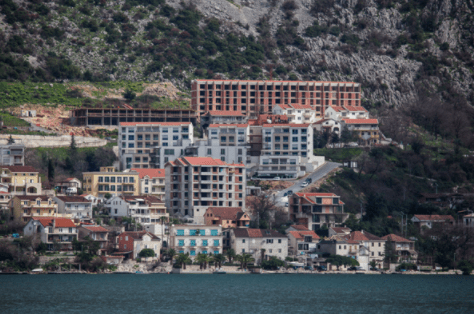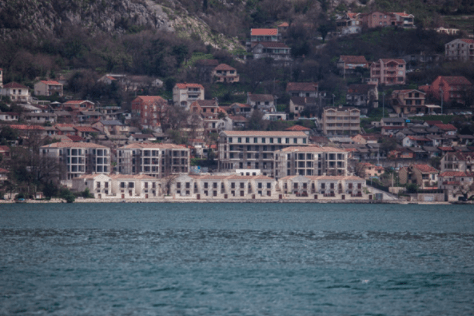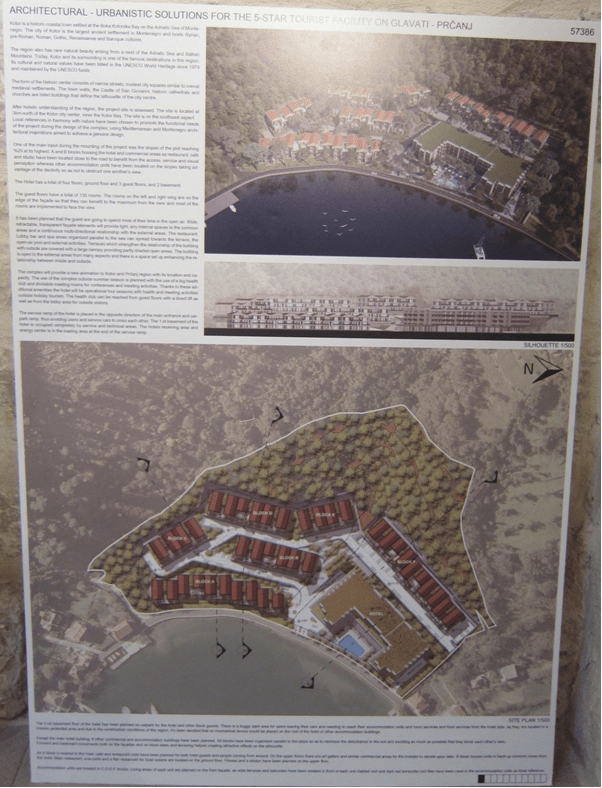April 26, 2018 - The “Friends of Boka Heritage” association issued a letter to the Committee for World Heritage UNESCO and the International Council for monuments ICOMOS regarding the “Condition Report” in Kotor which was published by the National Committee for collaboration with UNESCO where they claim that “the information in this document is given in a way that does not entirely reflect the state of the protected area”.
In the letter delivered to UNESCO and ICOMOS by the eminent experts for area planning and protection of cultural heritage, following the statements from the “Condition Report”, they also added information related to the most problematic locations in the Bay – Dobrota camp, Glavati, Kostanjica, Perast and Turski rt, and the Law on planning and constructing objects, which enables the continuing devastation of the natural and cultural-historical area in Kotor. They also submitted the Study for the protection of cultural goods in the Municipality of Kotor, completed in May 2015, but officially published only on 28th November 2017 which, in the meantime, enabled the construction of the localities above contrary to the measures described in the Study.

“Although the Government of Montenegro has made the 'Decision on forbidding construction in the area which borders with the natural and cultural-historical area in Kotor until the approval of the spatial-urbanistic plan for the Municipality of Kotor', at the assembly on the 30th of March 2017, and on the basis of the Action plan from February 2017, the construction works, in reality, haven’t been stopped which is witnessed by numerous sites. Although the explanations are related to the fact that only the objects for which building permits were issued before the approval of this Decision are being constructed, these interventions are very significant and are leaving significant impacts on the area of Kotor”, said the Friends of Boka Heritage association.
One of the presently most problematic issues is the construction in Dobrota, especially in Kamp, where a coastal tourism apartment complex is being constructed with a five-floor residential building behind it. “This was one of the rare preserved green areas in between the traditional groups of houses in the coastal part of Dobrota, where among hundreds of centuries-old oak trees, there was a ground floor car camp from the 60’s. Although the conservatory conditions by the Cultural heritage directorate from January 2014 defined that the existing trees should be kept, and construction carried out around them, as well as that the flooring of the objects can be at most consisted of the ground floor, and although an initiative by eminent experts from Boka was delivered in March 2015 to protect the Car camp complex in Dobrota legally, the object was demolished in April 2015, almost all centuries-old trees were cut, and construction of the touristic complex began”.
In the area of this complex called 'Dobrota Palazzi', right along the coast, a hotel with villas is being constructed as well as a “private beach with lounge” filling several thousand cubic meters of sand in the length of 120 meters. There is also a plan to build two breakwaters in the length of 30 meters which is contrary to the clause 18 from the Law on natural and cultural-historical protection of Kotor which states that “Within the area of Kotor the existing line cannot be changed and carrying out sand filling on the coast is not allowed except in case of its revitalization, in accordance with the Law.” In the association, they are mostly concerned about the fact that this “incident in the area” can cause a chain reaction in the sense of similar interventions at many other locations within the Kotor area.
“Although in the Decision made by the Committee for World Heritage from 2016, there is a demand to stop further construction in Kostanjica, today, this location is bigger than when that Decision was made, and the Municipality of Kotor received requests for issuing building permits for another 21 new objects”, the letter stated.

The World Heritage Committee, in the 2016 Decision, has demanded that the construction of planned tourist capacities at Glavati-Prcanj should be done to evaluate the impact on the cultural heritage for PUP (Spatial Urban Plan) and the individual HIA study (Study of Impact on Heritage) for the specific location, as extremely important for the universal value of the area. On the 27th of March 2017, the Municipality of Kotor issued the International Anonymous Competition No. 2 for the Preliminary Urban-Architectural Solution for a 5 Star Category Tourist Resort, Urban Plot Up6, Block 2, within the location study "Glavati-Prcanj", in the invitation itself, stating that the future of the upcoming project will depend on of the results of the HIA study and that, if the investor decides that based on the guideline of the conceptual solution it is developed further for the technical documentation, they would do it at their own risk, even if these estimates do not permit construction on the site in question.
The Friends of Boka Heritage Association considered it problematic that the competition was even published before the completion of HIA and the issuance of conservation conditions for this location, and that the jury was not considering the solutions and awarded works that would obviously undermine the attributes of the extraordinary, unique value of the Kotor area.
"Meanwhile, on the 25th of January 2018, the company Hexagon Investments d.o.o. Podgorica, the current owner of Glavati Land, submitted a request to issue urban-technical conditions for the relocation of existing cable lines to the Ministry of Sustainable Development and Tourism. At the end of March 2018, preparatory works on cable relocation began, although the HIA for this location has neither been made nor has been submitted to the World Heritage Committee. Also, the project documentation has not been submitted to the Management Board for the Protection of Cultural Property."
From May 2015 until November 2017, when the Study on the Protection of Cultural Goods in the area of the Kotor Municipality was adopted for the needs of the PUP Kotor, a plan document was also approved that enabled the construction of Glavati (Local study of location Glavati-Prcanj), and a facility was built at the Turkish cape as well as the aforementioned tourist resort at the Dobrota Campsite, which is contrary to the measures defined in the Study, warned the committee by UNESCO and ICOMOS experts for Protection and Planning.

It is noteworthy that the Heritage Impact Assessment-HIA for the whole area, which was intended to estimate the influence of current planning documents adopted by the Government of Montenegro on the 10th of November 2017, was before the Cultural Property Protection Study for the same area. The heritage supporters ask a question about the HIA - how could the Government of Montenegro adopt this document before submitting it to the World Heritage Center to be reviewed by the advisory bodies even though the World Heritage Committee's decision is stipulated? Nevertheless, in the meantime, the amendments to the Law on Protection of the Natural and Cultural-Historic Area of Kotor foresees that the Government of Montenegro will issue the HIA for five years.
The Visual Impact Study, made in 2013, discarded the possibility of building a bridge at Verige, estimating that such an intervention would have seriously jeopardized the universal values of the Area. "However, on February 2nd, 2017, at the same session of the Government on which the Action Plan of the Ministry of Culture was adopted to meet the requirements of the UNESCO Committee, one of the items on the agenda was 'Verbal information on negotiations with the Republic of Azerbaijan regarding the construction of the Verige Bridge'".
The Society of Friends of the Boka Heritage, addressing UNESCO and ICOMOS, underlines that in the period between the two sessions of the Committee, to which Montenegro reports to this international organization, the Law on planning space and construction of facilities was adopted, which was opposed by the experts and the public in Montenegro because of the extremely centralistic concept that the Ministry of Sustainable Development and Tourism does all the work of drafting and implementing document plans, but also because of the exclusion of local self-government from the decision-making process in planning their own territories. Also, this Law does not comply with the Act on the Protection of Cultural Property, and the treatment of cultural goods and heritage in it is superficial and imprecise, and its consequences are already visible in practice.
As an example, they emphasize the reconstruction of the Smekja-fabric Jadran palace complex in the historical core of Perast, in which the works began in December 2017, and only after the report to the inspection by Perast citizens in March 2018 was it stated that the project was not approved by the Management Board for the protection of cultural goods, which is obligatory under the Law on the Protection of Cultural Property. This example suggests that implementation of the most complex and most sensitive restoration works and interventions in the historic core of Kotor is carried out without control of the protection service.

"We want to point out that our goal of addressing you is not the desire for the Kotor area to lose its status on the World Heritage List, but on the contrary, as we hope to get your help in preventing further devastation of this region and losing the attributes of the extraordinary universal value. We believe that for future decisions of the World Heritage Committee, it would be useful for UNESCO experts to visit the Kotor area and see the conditions on the field.
We especially urge you to give an immediate response regarding the Glavati location that can still be preserved. This is referring to the UNESCO / ICOMOS Advisory Mission Report from 2013 and to the decisions from Doha and Istanbul in which Glavati is listed as a site of importance for preserving the attributes of exceptional universal value of the Kotor area for which an impact assessment is required to ensure that it will not have an impact on outstanding global value," the letter concluded. The letter also included many accompanying photographs and drawings and is signed by Marija Nikolić, dipl. Eng. arch., planner, Aleksandra Kapetanović, dipl. Arch., Conservatory, Katarina Nikolić, B.Sc. Eng. Arch., Conservatory, Jasminka Grgurević, B.Sc. conservator-restorer, Slobodan Mitrović, B.Sc. Archbishop and Dr. Stevan Kordic, mathematician and photographer.








